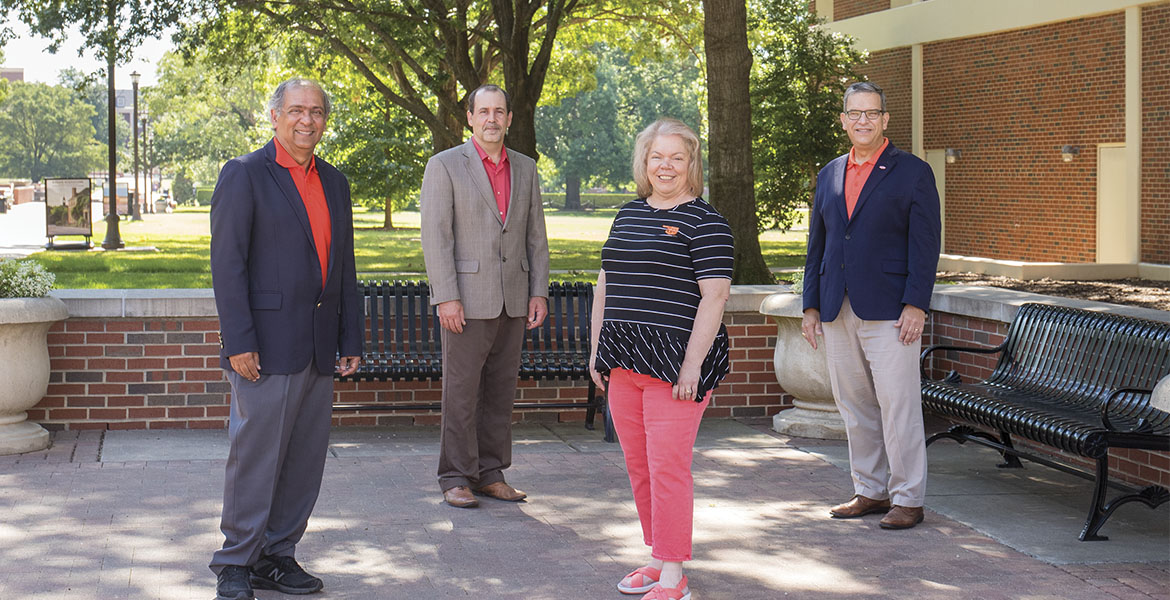
Oklahoma State modeling team tracks needs and spread in the pandemic
Thursday, September 3, 2020
As the state of Oklahoma fights the spread of COVID-19, a team with four Oklahoma State University faculty members is providing important information for Gov. Kevin Stitt’s plans and actions.
“We are focused primarily on trying to predict hospitalizations on a continuous basis — how many hospital beds are we going to need on a given day, ICU capacity, the number of ventilators used, and fatalities,” said Jared Taylor, an associate professor and epidemiologist in the Department of Veterinary Pathobiology at the College of Veterinary Medicine.
“As the statistician in the group, my role is to provide data analysis details and forecasting possibilities,” said Mindy McCann, a professor and department head of Statistics in the College of Arts and Sciences. “Our model is based primarily on epidemiology science, but there are parameters of the model that need to be estimated. Fine-tuning the model to predict the important metrics such as number of hospital beds needed, number of ICU beds needed, number of ventilators needed and number of deaths, requires some data analysis concepts.”
This information was vital to the state’s plans to reopen the economy.
The team, which also included OSU’s Goutam Chakraborty, professor of marketing and director of MS in Business Analytics and Data Science in the Spears School of Business, and Glen Krutz, Puterbaugh Foundation Chair, political science professor and dean of the College of Arts and Sciences, worked with a team from the University of Oklahoma and interim state epidemiologist Aaron Wendelboe. They presented preliminary findings to the governor and members of his cabinet in Oklahoma City and continue to update their research weekly.
“The team meets regularly to discuss the trends and modify the model as needed,” Kurtz said. “We then meet weekly with members from the OU modeling team and together we send our two models to state leaders.”
Taylor anticipates continuing this work for some time.
“We talk pretty much every day,” he said. “The time demand has been extraordinary. I usually put in 40 hours a week doing this alone besides my regular job of teaching and conducting research. We may very well go on beyond the summer, depending on when the second wave comes and maybe even a third wave and how prepared we are to deal with that.
“Our job is to make sure we have a tool that helps decision-makers moving forward make the best decisions they can.”
While Oklahoma hasn’t seen the numbers of COVID-19 cases that states like New York and California have, it hasn’t escaped the spread of the pandemic, either. And the state presents its own unique challenges.
“One unique aspect of our model is that we tried to take into account the demographics of our state in terms of urban versus rural population and the age demographics of our population,” Taylor said. “We have already seen a notable shift to more cases in rural communities than proportionately we should. Obviously, they are still not big numbers — those are still associated with the cities. However, when you look at the proportion of the population that’s in the cities versus the rural areas, we are seeing disproportionately more cases in the rural areas. Our fear is that it’s just been a slower process developing. As communities reopen, we fear the rural communities are going to begin bearing an even heavier burden of disease relative to other parts of the state.”
“I would like the public to know that we have them in mind as we rigorously sift through the situation and the data,” Krutz said. “We are doing the best we can to provide reliable data and predictions to improve decision-making by state leaders and university leaders. This is not always an exact science. Our predictions especially require us to draw assumptions about human behavior and disease spread. So, for example, how to modify our model based on the gradual ‘re-opening’ of Oklahoma was a team meeting that took many hours.”
As the state began to reopen, Taylor offered some words of advice.
“Where we go from here depends upon people and their actions and choices. We understand the economic consequences and pain caused by the shutdown,” he said. “But there will be a second wave. What that second wave looks like, I believe, is really going to depend on the choices and behaviors people engage in. … We should continue to practice social distancing as best we can. We should consider using masks, sanitation, all of those behaviors. It’s important that we keep people healthy. What happens next will depend upon the actions and behaviors of people.”
